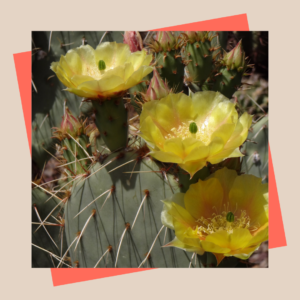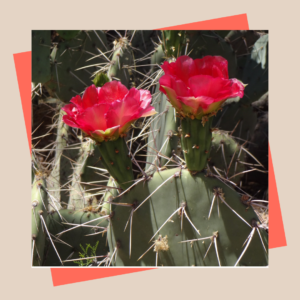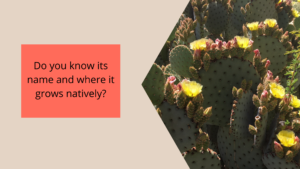
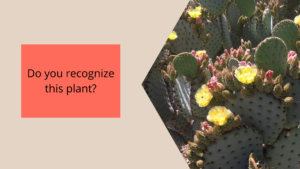
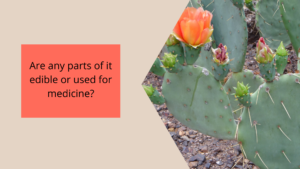
This is a picture of a Prickly Pear cactus. You may know it by a different name as there are at least 18 varieties of prickly pear having different scientific and local labels. They are native to the western hemisphere, ranging from southern Canada to Southern South America. However, because 16th century sailors were so fascinated by the prickly pear that they couldn’t resist taking home a souvenir plant, you will also find them growing in such diverse places as Italy, India, Ceylon, South Africa and Australia. They are perhaps the “world travelers” of the cactus family.
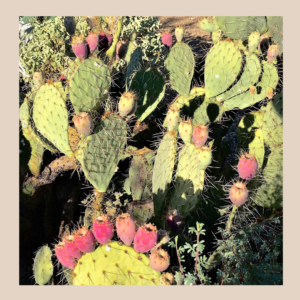 The Prickly Pear belongs to a genus of cactus known as the Opuntia because of four special characteristics. First, these cacti are made up of distinct, jointed segments, unlike the saguaro which has long smooth arms. The joints are created because when the weather gets dry, the segment just stops growing and seals itself off. Then, when there is moisture again, the cactus puts out a new joint by branching from the closest areoles (a modified branch that looks like a light or dark-colored bump on the cactus). This gives them a distinct, kind of “cobbled together” appearance. Second, where each of the new joints is formed, there are the beginnings of new leaves. Third, although not all family members have long spines, they all have glochids or small barbed bristles that are sharp, brittle and easily detached. And finally, instead of having shiny black seeds like most cacti, the Opuntia have a pale covering (an aril) over their seeds.
The Prickly Pear belongs to a genus of cactus known as the Opuntia because of four special characteristics. First, these cacti are made up of distinct, jointed segments, unlike the saguaro which has long smooth arms. The joints are created because when the weather gets dry, the segment just stops growing and seals itself off. Then, when there is moisture again, the cactus puts out a new joint by branching from the closest areoles (a modified branch that looks like a light or dark-colored bump on the cactus). This gives them a distinct, kind of “cobbled together” appearance. Second, where each of the new joints is formed, there are the beginnings of new leaves. Third, although not all family members have long spines, they all have glochids or small barbed bristles that are sharp, brittle and easily detached. And finally, instead of having shiny black seeds like most cacti, the Opuntia have a pale covering (an aril) over their seeds.
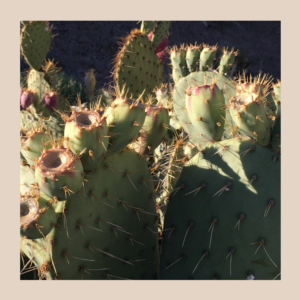 Prickly Pears are well known in Arizona as a favorite of landscapers and for the variety of products made from their beautiful purplish red fruit. The fruit of the prickly pear is called tuna or cactus fig. This fruit can be eaten raw by humans, but the seeds are best when they have been dried or they can cause indigestion. The juice of the fruit is tasty and can be made into syrup, jelly, pies, candy or drinks. The flower petals are also edible and can be used for garnish. Especially popular products in the southwest are prickly pear salad dressing and prickly pear margaritas! Ole!
Prickly Pears are well known in Arizona as a favorite of landscapers and for the variety of products made from their beautiful purplish red fruit. The fruit of the prickly pear is called tuna or cactus fig. This fruit can be eaten raw by humans, but the seeds are best when they have been dried or they can cause indigestion. The juice of the fruit is tasty and can be made into syrup, jelly, pies, candy or drinks. The flower petals are also edible and can be used for garnish. Especially popular products in the southwest are prickly pear salad dressing and prickly pear margaritas! Ole!
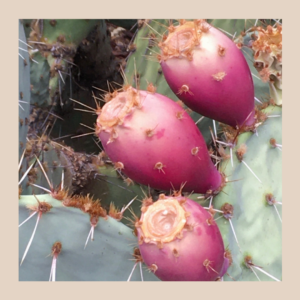 The cactus pads are full of oxalic acid which is somewhat toxic for humans. People can eat the pads raw in the early spring when the oxalic acid levels are low or anytime if the pads have been boiled to leach out the acid. The pads have a cooked consistency similar to okra and were used by the native peoples to thicken stews. Called nopal by the Spanish, the pads are an important part of Mexican cuisine.
The cactus pads are full of oxalic acid which is somewhat toxic for humans. People can eat the pads raw in the early spring when the oxalic acid levels are low or anytime if the pads have been boiled to leach out the acid. The pads have a cooked consistency similar to okra and were used by the native peoples to thicken stews. Called nopal by the Spanish, the pads are an important part of Mexican cuisine.
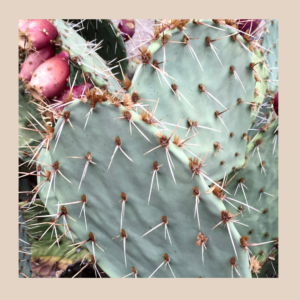 Both the pads and the fruit are eaten by pack rats, jackrabbits, havelina, and insects. Like most desert plants, the prickly pear is well defended by spines to ensure that the species will survive. Humans had to figure out techniques to strip off the spines so that they could get to the edible parts. Native peoples used to rub the cactus in the sand to grind off the glochids, whereas the early cowboys used to burn them off over their campfires. U-tube has several entertaining and educational videos describing the best ways for modern cooks to de-spine their prickly pears.
Both the pads and the fruit are eaten by pack rats, jackrabbits, havelina, and insects. Like most desert plants, the prickly pear is well defended by spines to ensure that the species will survive. Humans had to figure out techniques to strip off the spines so that they could get to the edible parts. Native peoples used to rub the cactus in the sand to grind off the glochids, whereas the early cowboys used to burn them off over their campfires. U-tube has several entertaining and educational videos describing the best ways for modern cooks to de-spine their prickly pears.
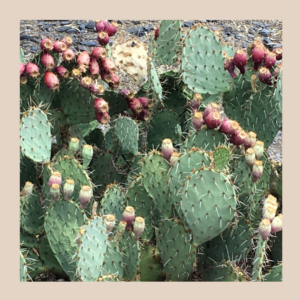 The prickly pear fruit is currently being tested for a variety of medicinal treatments. The juice is being used to treat Type 2 diabetes among some of the native populations. This is because it contains both fiber and pectin which can lower blood glucose by decreasing sugar in the stomach and intestines. It is also being tested to determine its effectiveness in reducing high cholesterol, obesity, diarrhea, and viral infections. It seems to work on reducing the effects of an alcohol hangover, but only if you take it before you start drinking. The juice from the pads has also been used topically to treat cuts, bruises and inflammation of the skin.
The prickly pear fruit is currently being tested for a variety of medicinal treatments. The juice is being used to treat Type 2 diabetes among some of the native populations. This is because it contains both fiber and pectin which can lower blood glucose by decreasing sugar in the stomach and intestines. It is also being tested to determine its effectiveness in reducing high cholesterol, obesity, diarrhea, and viral infections. It seems to work on reducing the effects of an alcohol hangover, but only if you take it before you start drinking. The juice from the pads has also been used topically to treat cuts, bruises and inflammation of the skin.
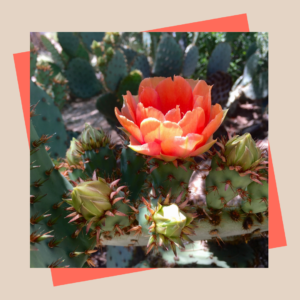 In addition to their usefulness in food and healing, prickly pears do much to brighten up the desert environment and contribute to the arts. In the spring when they begin to bloom, they put on a display of yellow, orange, red, pink or magenta blossoms which are a favorite subject for local artists. They also attract bees and hummingbirds. When the blossoms fall, the fruits have formed and gradually turn from green to dark purplish red. Besides the many uses for the fruit described already, they are also valued as a source of natural cochineal dye in carmine red. This is used not only to dye textiles, but in cosmetics, pharmaceuticals and even in waterproof paint for your home. The prickly pear is indeed a most versatile and valuable plant.
In addition to their usefulness in food and healing, prickly pears do much to brighten up the desert environment and contribute to the arts. In the spring when they begin to bloom, they put on a display of yellow, orange, red, pink or magenta blossoms which are a favorite subject for local artists. They also attract bees and hummingbirds. When the blossoms fall, the fruits have formed and gradually turn from green to dark purplish red. Besides the many uses for the fruit described already, they are also valued as a source of natural cochineal dye in carmine red. This is used not only to dye textiles, but in cosmetics, pharmaceuticals and even in waterproof paint for your home. The prickly pear is indeed a most versatile and valuable plant.
